Hydrological Behaviour of Extensive Green Roofs with Native Plants in the Humid Subtropical Climate Context
Abstract
:1. Introduction
2. Materials and Methods
3. Results
3.1. Precipitation and Temperature
3.2. Analysis of the Outflows from the Microcosms of the Green Roof
4. Discussion
5. Conclusions
Author Contributions
Funding
Institutional Review Board Statement
Informed Consent Statement
Data Availability Statement
Conflicts of Interest
References
- Busato, F.; Lazzarin, R.M.; Noro, M. Three years of study of the Urban Heat Island in Padua: Experimental results. Sustain. Cities Soc. 2014, 10, 251–258. [Google Scholar] [CrossRef]
- Scalenghe, R.; Marsan, F.A. The anthropogenic sealing of soils in urban areas. Landsc. Urban Plan. 2009, 90, 1–10. [Google Scholar] [CrossRef]
- Mirzaei, P.A.; Haghighat, F. Approaches to study Urban Heat Island–Abilities and limitations. Build. Environ. 2010, 45, 2192–2201. [Google Scholar] [CrossRef]
- Salata, F.; Golasi, I.; Petitti, D.; Petitti, D.; Vollaro, E.d.L.; Coppi, M.; Vollaro, A.d.L. Relating microclimate. human thermal comfort and health during heat waves: An analysis of heat island mitigation strategies through a case study in an urban outdoor environment. Sustain. Cities Soc. 2017, 30, 79–96. [Google Scholar] [CrossRef]
- Schinasi, L.H.; Benmarhnia, T.; De Roos, A.J. Modification of the association between high ambient temperature and health by urban microclimate indicators: A systematic review and meta-Analysis. Environ. Res. 2018, 161, 168–180. [Google Scholar] [CrossRef]
- Rosenfeld, A.H.; Akbari, H.; Romm, J.J.; Pomerantz, M. Cool communities: Strategies for heat island mitigation and smog reduction. Energy Build. 1998, 28, 51–62. [Google Scholar] [CrossRef]
- Onmura, S.; Matsumoto, M.; Hokoi, S. Study on evaporative cooling effect of roof lawn garden. Energy Build. 2001, 33, 653–666. [Google Scholar] [CrossRef]
- Ouldboukhitine, S.E.; Belari, R.; Jaffal, I.; Trabelsi, A. Assessment of green roof thermal behavior: A coupled heat and mass transfer model. Build. Environ. 2011, 46, 26242631. [Google Scholar] [CrossRef]
- Qiu, G.; Li, H.; Zhang, Q.; Chen, W.; Liang, X.; Li, X. Effects of Evapotranspiration on Mitigation of Urban Temperature by Vegetation and Urban Agriculture. J. Integr. Agr. 2013, 12, 1307–1315. [Google Scholar] [CrossRef]
- Speak, A.F.; Rothwell, J.J.; Lindley, S.J.; Smith, C.L. Reduction of the urban cooling effects of an intensive green roof due to vegetation damage. Urban Clim. 2013, 3, 40–55. [Google Scholar] [CrossRef]
- Nowak, D.J.; Crane, D.E.; Stevens, J.C. Air pollution removal by urban trees and shrubs in the United States. Urban For. Urban Green. 2006, 4, 115–123. [Google Scholar] [CrossRef]
- Viecco, M.; Vera, S.; Jorquera, H.; Bustamante, W.; Gironás, J.; Dobbs, C.; Leiva, E. Potential of Particle Matter Dry Deposition on Green Roofs and Living Walls Vegetation for Mitigating Urban Atmospheric Pollution in Semiarid Climates. Sustainability 2018, 10, 2431. [Google Scholar] [CrossRef] [Green Version]
- Yang, J.; Yu, Q.; Gong, P. Quantifying air pollution removal by green roofs in Chicago. Atmos. Environ. 2008, 42, 7266–7273. [Google Scholar] [CrossRef]
- Barrio, E.P.D. Analysis of the green roofs cooling potential in buildings. Energy Build. 1998, 27, 179–193. [Google Scholar] [CrossRef]
- Eumorfopoulou, E.; Aravantinos, D. The contribution of a planted roof to the thermal protection of buildings in Greece. Energy Build. 1998, 27, 29–36. [Google Scholar] [CrossRef]
- Akbari, H.; Pomerantz, M.; Taha, H. Cool surfaces and shade trees to reduce energy use and improve air quality in urban areas. Sol. Energy 2001, 70, 295–310. [Google Scholar] [CrossRef]
- Hodo-Abalo, S.; Banna, M.; Zeghmati, B. Performance analysis of a planted roof as a passive cooling technique in hot-Humid tropics. Renew. Energy 2012, 39, 140–148. [Google Scholar] [CrossRef]
- Coutts, A.M.; Tapper, N.J.; Beringer, J.; Loughnan, M.; Demuzere, M. Watering our cities: The capacity for Water Sensitive Urban Design to support urban cooling and improve human thermal comfort in the Australian context. Progr. Phys. Geog. 2013, 37, 2–28. [Google Scholar] [CrossRef]
- Coma, J.; Pérez, G.; Cabeza, L.F. Green Roofs to Enhance the Thermal Performance of Buildings and Outdoor Comfort. In Nature Based Strategies for Urban and Building; Butterworth-Heinemann: Oxford, UK, 2018; pp. 109–117. [Google Scholar]
- Kuronuma, T.; Watanabe, H.; Ishihara, T.; Kou, D.; Toushima, K.; Ando, M.; Shindo, S. CO2 Payoff of Extensive Green Roofs with Different Vegetation Species. Sustainability 2018, 10, 2256. [Google Scholar] [CrossRef] [Green Version]
- Brenneisen, S. Space for Urban Wildlife: Designing Green Roofs as Habitats in Switzerland. Urban Habitats 2006, 4, 1541–7115. [Google Scholar]
- Shazmin, S.A.A.; Sipan, I.; Sapri, M.; Jalil, R.A.; Mohammad, I.S. The effect of green envelope components on green building value. Prop. Manag. 2017, 35, 181–201. [Google Scholar]
- Cirella, G.; Iyalomhe, F. Flooding conceptual review: Sustainability-Focalized best practices in Nigeria. Appl. Sci. 2018, 8, 1558. [Google Scholar] [CrossRef] [Green Version]
- Lee, E.; Lee, Y.; Joo, J.; Jung, D.; Kim, J. Flood reduction in urban drainage systems: Cooperative operation of centralized and decentralized reservoirs. Water 2016, 8, 469. [Google Scholar] [CrossRef]
- Fabian, L. Extreme cities and isotropic territories: Scenarios and projects arising from the environmental emergency of the central Veneto città diffusa. Int. J. Disast. Risk Sci. 2012, 3, 11–22. [Google Scholar] [CrossRef] [Green Version]
- Munafò, M.; Congedo, L. Soil consumption monitoring in Italy. In Urban Expansion. Land Cover and Soil Ecosystem Services; Gardi, C., Ed.; Routledge: London, UK, 2017; pp. 217–230. [Google Scholar]
- Sofia, G.; Roder, G.; Dalla Fontana, G.; Tarolli, P. Flood dynamics in urbanised landscapes: 100 years of climate and humans’ interaction. Sci. Rep. 2017, 7, 40527. [Google Scholar] [CrossRef]
- Cazorzi, F.; Dalla Fontana, G.; Luca, A.D.; Sofia, G.; Tarolli, P. Drainage network detection and assessment of network storage capacity in agrarian landscape. Hydrol. Process. 2013, 27, 541–553. [Google Scholar] [CrossRef]
- Pijl, A.; Brauer, C.C.; Sofia, G.; Teuling, A.J.; Tarolli, P. Hydrologic impacts of changing land use and climate in the Veneto lowlands of Italy. Anthropocene 2018, 22, 20–30. [Google Scholar] [CrossRef]
- Wong, T.H.; Brown, R.R. The water sensitive city: Principles for practice. Water Sci. Technol. 2009, 60, 673–682. [Google Scholar] [CrossRef] [Green Version]
- Dietz, M.E. Low impact development practices: A review of current research and recommendations for future directions. Water Air Soil. Poll. 2007, 186, 351–363. [Google Scholar] [CrossRef]
- Woods-Ballard, B.; Kellagher, R.; Martin, P.; Jefferies, C.; Bray, R.; Shaffer, P. The SuDS Manual; CIRIA C697; CIRIA: London, UK, 2007. [Google Scholar]
- Davis, A.P.; Hunt, W.F.; Traver, R.G.; Clar, M. Bioretention technology: Overview of current practice and future needs. J. Environ. Eng. 2009, 135, 109–117. [Google Scholar] [CrossRef]
- Zanin, G.; Bortolini, L.; Borin, M. Assessing stormwater nutrient and heavy metal plant uptake in an experimental bioretention pond. Land 2018, 7, 150. [Google Scholar] [CrossRef] [Green Version]
- Bortolini, L.; Zanin, G. Hydrological behaviour of rain gardens and plant suitability: A study in the Veneto plain (north-Eastern Italy) conditions. Urban For. Urban Green. 2018, 34, 121–133. [Google Scholar] [CrossRef]
- Burek, P.; Mubareka, S.; Rojas, R.; De Roo, A.; Bianchi, A.; Baranzelli, C.; Lavalle, C.; Vandecasteele, I. Evaluation of the Effectiveness of Natural Water Retention Measures-Support to the EU Blueprint to Safeguard Europe’s Waters. Hum. Organ. 2012, 259, 7–11. [Google Scholar]
- VanWoert, N.D.; Rowe, D.B.; Andresen, J.A.; Rugh, C.L.; Xiao, L. Watering regime and green roof substrate design affect Sedum plant growth. HortScience 2005, 40, 659–664. [Google Scholar] [CrossRef] [Green Version]
- Berndtsson, C.J. Green roof performance towards management of runoff water quantity and quality: A review. Ecol. Eng. 2010, 36, 351–360. [Google Scholar] [CrossRef]
- Berardi, U.; GhaffarianHoseini, A. State-Of-The-Art analysis of the environmental benefits of green roofs. Appl. Energ. 2014, 115, 411–428. [Google Scholar] [CrossRef]
- Li, Y.; Babcock, R.W. Green roof hydrologic performance and modelling: A review. Water Sci. Technol. 2014, 69, 727–738. [Google Scholar] [CrossRef]
- Stovin, V.; Poë, S.; De-Ville, S.; Berretta, C. The influence of substrate and vegetation configuration on green roof hydrological performance. Ecol. Eng. 2015, 85, 159–172. [Google Scholar] [CrossRef] [Green Version]
- Soulis, K.X.; Ntoulas, N.; Nektarios, P.A.; Kargas, G. Runoff reduction from extensive green roofs having different substrate depth and plant cover. Ecol. Eng. 2017, 102, 80–89. [Google Scholar] [CrossRef]
- Ercolani, G.; Chiaradia, E.A.; Gandolfi, C.; Castelli, F.; Masseroni, D. Evaluating performances of green roofs for stormwater runoff mitigation in a high flood risk urban catchment. J. Hydrol. 2018, 566, 830–845. [Google Scholar] [CrossRef]
- Gong, Y.; Yin, D.; Fang, X.; Li, J. Factors affecting runoff retention performance of extensive green roofs. Water 2018, 10, 1217. [Google Scholar] [CrossRef] [Green Version]
- Pęczkowski, G.; Kowalczyk, T.; Szawernoga, K.; Orzepowski, W.; Żmuda, R.; Pokładek, R. Hydrological performance and Runoff water quality of experimental green roofs. Water 2018, 10, 1185. [Google Scholar] [CrossRef] [Green Version]
- Palermo, S.A.; Turco, M.; Principato, F.; Piro, P. Hydrological effectiveness of an extensive green roof in Mediterranean Climate. Water 2019, 11, 1378. [Google Scholar] [CrossRef] [Green Version]
- Oberndorfer, E.; Lundholm, J.; Bass, B.; Coffman, R.R.; Doshi, H.; Dunnett, N.; Gaffin, S.; Köhler, M.; Liu, K.K.Y.; Rowe, B. Green roofs as urban ecosystems: Ecological structures, functions and services. BioScience 2007, 57, 823–833. [Google Scholar] [CrossRef]
- Morgan, S.; Celik, S.; Retzlaff, W. Green Roof Storm-Water Runoff Quantity and Quality. J. Environ. Eng. 2013, 139, 471–478. [Google Scholar] [CrossRef]
- Shafique, M.; Kim, R.; Kyung-Ho, K. Green roof for stormwater management in a highly urbanized area: The case of Seoul. Korea. Sustainability 2018, 10, 584. [Google Scholar] [CrossRef] [Green Version]
- Locatelli, L.; Guerrero, M.; Russo, B.; Martínez-Gomariz, E.; Sunyer, D.; Martínez, M. Socio-Economic Assessment of Green Infrastructure for Climate Change Adaptation in the Context of Urban Drainage Planning. Sustainability 2020, 12, 3792. [Google Scholar] [CrossRef]
- Zhou, Q.; Halsnæs, K.; Arnbjerg-Nielsen, K. Economic assessment of climate adaptation options for urban drainage design in Odense, Denmark. Water Sci. Technol. 2012, 66, 1812–1820. [Google Scholar] [CrossRef] [Green Version]
- Alves, A.; Gersonius, B.; Kapelan, Z.; Vojinovic, Z.; Sanchez, A. Assessing the Co-Benefits of green-Blue-Grey infrastructure for sustainable urban flood risk management. J. Environ. Manag. 2019, 239, 244–254. [Google Scholar] [CrossRef]
- Dunnett, N.; Nagase, A.; Booth, R.; Grime, P. Influence of vegetation composition on runoff in two simulated green roof experiments. Urban Ecosyst. 2008, 11, 385–398. [Google Scholar] [CrossRef]
- Wolf, D.; Lundholm, J.T. Water uptake in green roof microcosms: Effects of plant species and water availability. Ecol. Eng. 2008, 33, 179–186. [Google Scholar] [CrossRef]
- Szota, C.; Farrell, C.; Williams, N.S.; Arndt, S.K.; Fletcher, T.D. Drought-Avoiding plants with low water use can achieve high rainfall retention without jeopardising survival on green roofs. Sci. Total. Environ. 2017, 603, 340–351. [Google Scholar] [CrossRef] [PubMed]
- Zhang, Z.; Szota, C.; Fletcher, T.D.; Williams, N.S.; Werdin, J.; Farrell, C. Influence of plant composition and water use strategies on green roof stormwater retention. Sci. Total. Environ. 2018, 625, 775–781. [Google Scholar] [CrossRef] [PubMed]
- Barbi, A.; Cagnati, A.; Cola, G.; Checchetto, F.; Chiaudani, A.; Crepaz, A.; Delillo, I.; Mariani, L.; Marigo, G.; Meneghin, P.; et al. Atlante Climatico del Veneto; Regione del Veneto: Mestre, Italy, 2013. [Google Scholar]
- Zanin, G.; Bettella, F.; Bortolini, L. Hydrological and plant performance of green roofs in the climate context of the Veneto Plain (north-Eastern Italy): Preliminary results. Acta Hortic. 2018, 1215, 95–100. [Google Scholar] [CrossRef]
- Bettella, F.; D’Agostino, V.; Bortolini, L. Drainage flux simulation of green roofs under wet conditions. J. Agric. Eng. 2018, 49, 242–252. [Google Scholar] [CrossRef] [Green Version]
- Allen, R.G.; Pereira, L.S.; Raes, D.; Smith, M. Crop Evapotranspiration-Guidelines for Computing Crop Water Requirements-FAO Irrigation and Drainage Paper 56; FAO: Rome, Italy, 1998. [Google Scholar]
- Berti, A.; Tardivo, G.; Chiaudani, A.; Rech, F.; Borin, M. Assessing reference evapotranspiration by the Hargreaves method in north-eastern Italy. Agric. Water Man. 2014, 140, 20–25. [Google Scholar] [CrossRef]
- Zanin, G.; Bortolini, L. Performance of three different native plant mixtures for extensive green roofs in the humid subtropical climate context. Water 2020, 12, 3484. [Google Scholar] [CrossRef]
- Sherrard Jr, J.A.; Jacobs, J.M. Vegetated roof water-balance model: Experimental and model results. J. Hydrol. Eng. 2012, 17, 858–868. [Google Scholar] [CrossRef]
- Schroll, E.; Lambrinos, J.; Righetti, T.; Sandrock, D. The role of vegetation in regulating stormwater runoff from green roofs in a winter rainfall climate. Ecol. Eng. 2011, 37, 595–600. [Google Scholar] [CrossRef]
- Mentens, J.; Raes, D.; Hermy, M. Green roofs as a tool for solving the rainwater runoff problem in the urbanised 21st century. Landsc. Urban Plan. 2006, 77, 217–226. [Google Scholar] [CrossRef]
- Palla, A.; Gnecco, I.; Lanza, L.G. Hydrologic restoration in the urban environment using green roofs. Water 2010, 2, 140–154. [Google Scholar] [CrossRef]
- Simmons, M.T.; Gardiner, B.; Windhager, S.; Tinsley, J. Green roofs are not created equal: The hydrologic and thermal performance of six different extensive green roofs and reflective and non-Reflective roofs in a sub-Tropical climate. Urban Ecosyst. 2008, 11, 339–348. [Google Scholar] [CrossRef]
- Cipolla, S.S.; Maglionico, M.; Stojkov, I. A long-Term hydrological modelling of an extensive green roof by means of SWMM. Ecol. Eng. 2016, 95, 876–887. [Google Scholar] [CrossRef]
- Villarreal, E.L.; Bengtsson, L. Response of a Sedum green-Roof to individual rain events. Ecol. Eng. 2005, 25, 1–7. [Google Scholar] [CrossRef]
- Stovin, V. The potential of green roofs to manage urban stormwater. Water Environ. J. 2010, 24, 192–199. [Google Scholar] [CrossRef]
- Stovin, V.; Vesuviano, G.; Kasmin, H. The hydrological performance of a green roof test bed under UK climatic conditions. J. Hydrol. 2012, 414, 148–161. [Google Scholar] [CrossRef]
- Viola, F.; Hellies, M.; Deidda, R. Retention performance of green roofs in representative climates worldwide. J. Hydrol. 2017, 553, 763–772. [Google Scholar] [CrossRef] [Green Version]
- VanWoert, N.D.; Rowe, D.B.; Andresen, J.A.; Rugh, C.L.; Fernandez, R.T.; Xiao, L. Green roof stormwater retention: Effects of roof surface, slope, and media depth. J. Environ. Qual. 2005, 34, 1036–1044. [Google Scholar] [CrossRef]
- Baryła, A.; Karczmarczyk, A.; Brandyk, A.; Bus, A. The influence of a green roof drainage layer on retention capacity and leakage quality. Water Sci.Technol. 2018, 77, 2886–2895. [Google Scholar] [CrossRef] [Green Version]
- Getter, K.L.; Rowe, D.B. The role of extensive green roofs in sustainable development. HortScience 2006, 4, 1276–1285. [Google Scholar] [CrossRef] [Green Version]
- Talebi, A.; Bagg, S.; Sleep, B.E.; O’Carroll, D.M. Water retention performance of green roof technology: A comparison of Canadian climates. Ecol. Eng. 2019, 126, 1–15. [Google Scholar] [CrossRef]
- Nagase, A.; Dunnett, N. Amount of water runoff from different vegetation types on extensive green roofs: Effects of plant species, diversity and plant structure. Landsc. Urban Plan. 2012, 104, 356–363. [Google Scholar] [CrossRef]
- Baryła, A.; Karczmarczyk, A.; Bus, A. Role of substrates used for green roofs in limiting rainwater runoff. J. Ecol. Eng. 2018, 19, 86–92. [Google Scholar] [CrossRef]
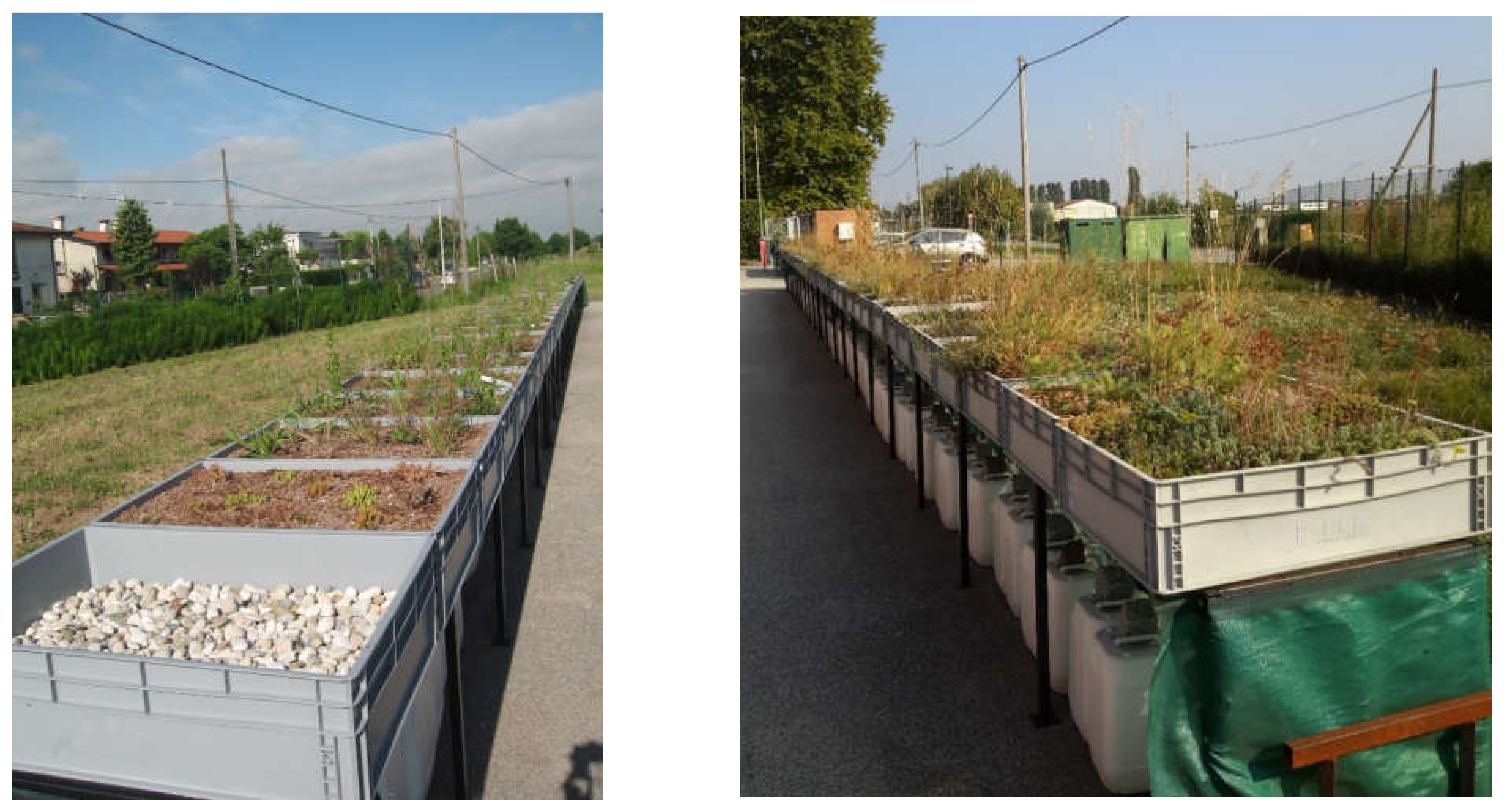
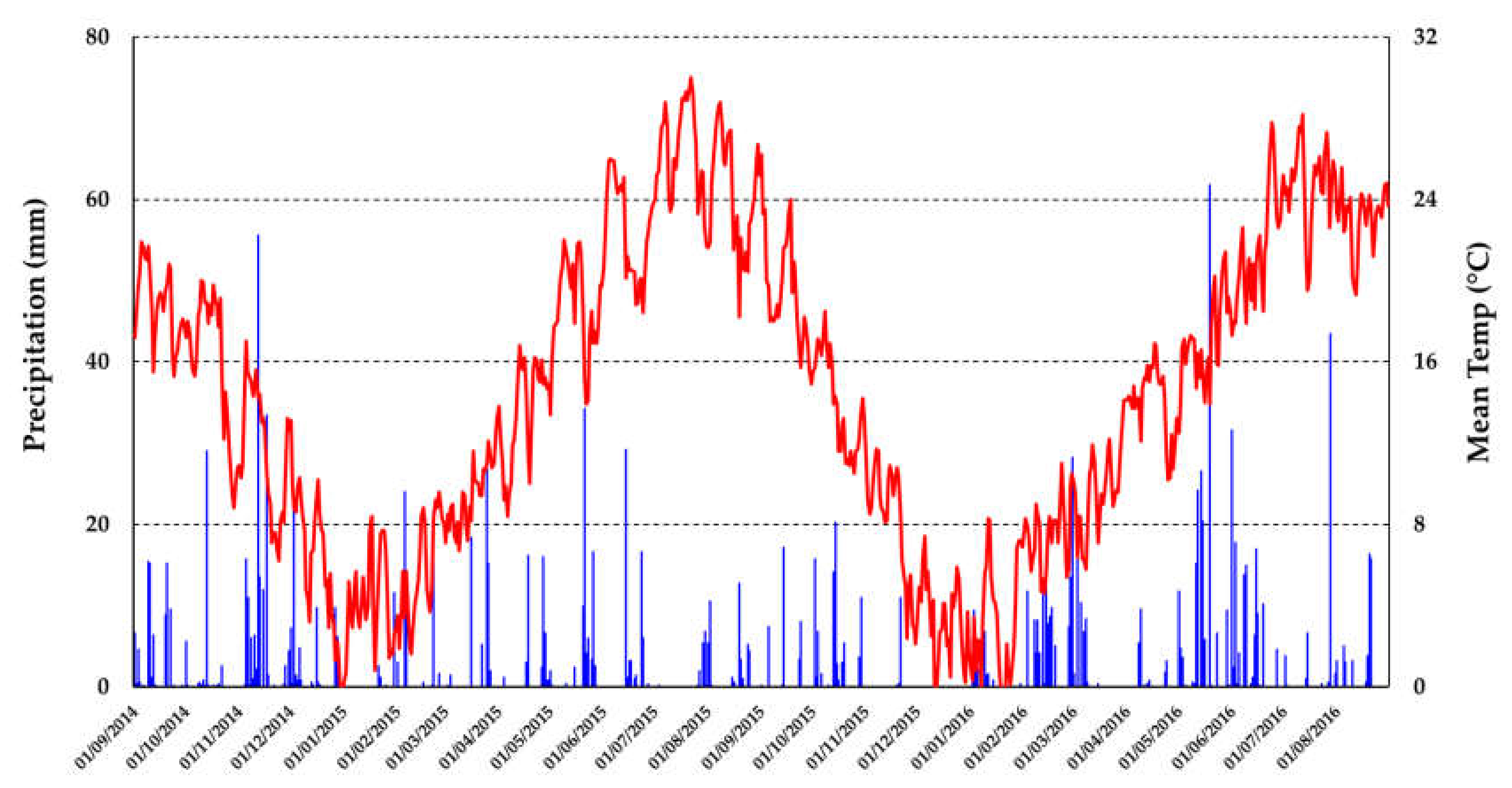
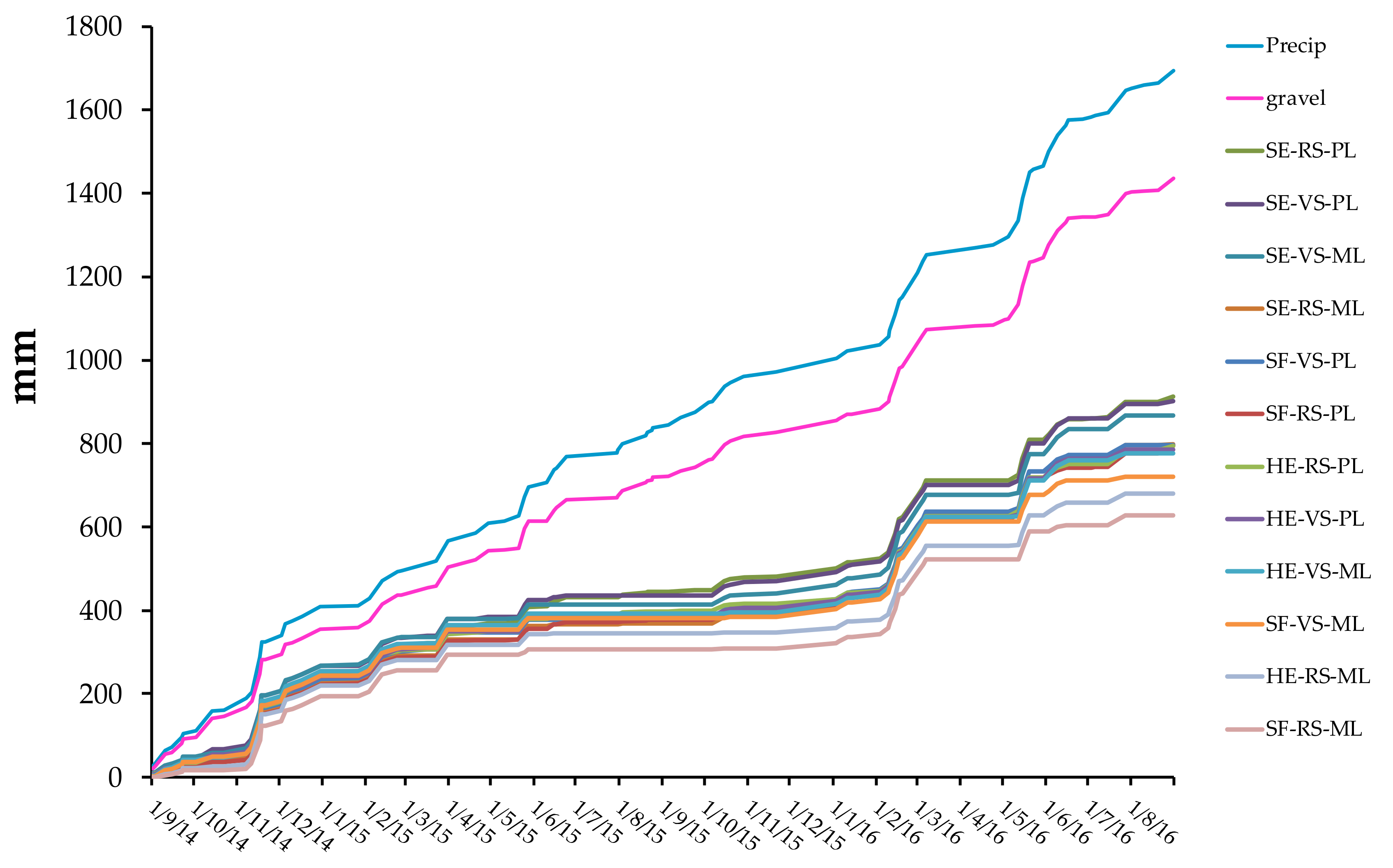
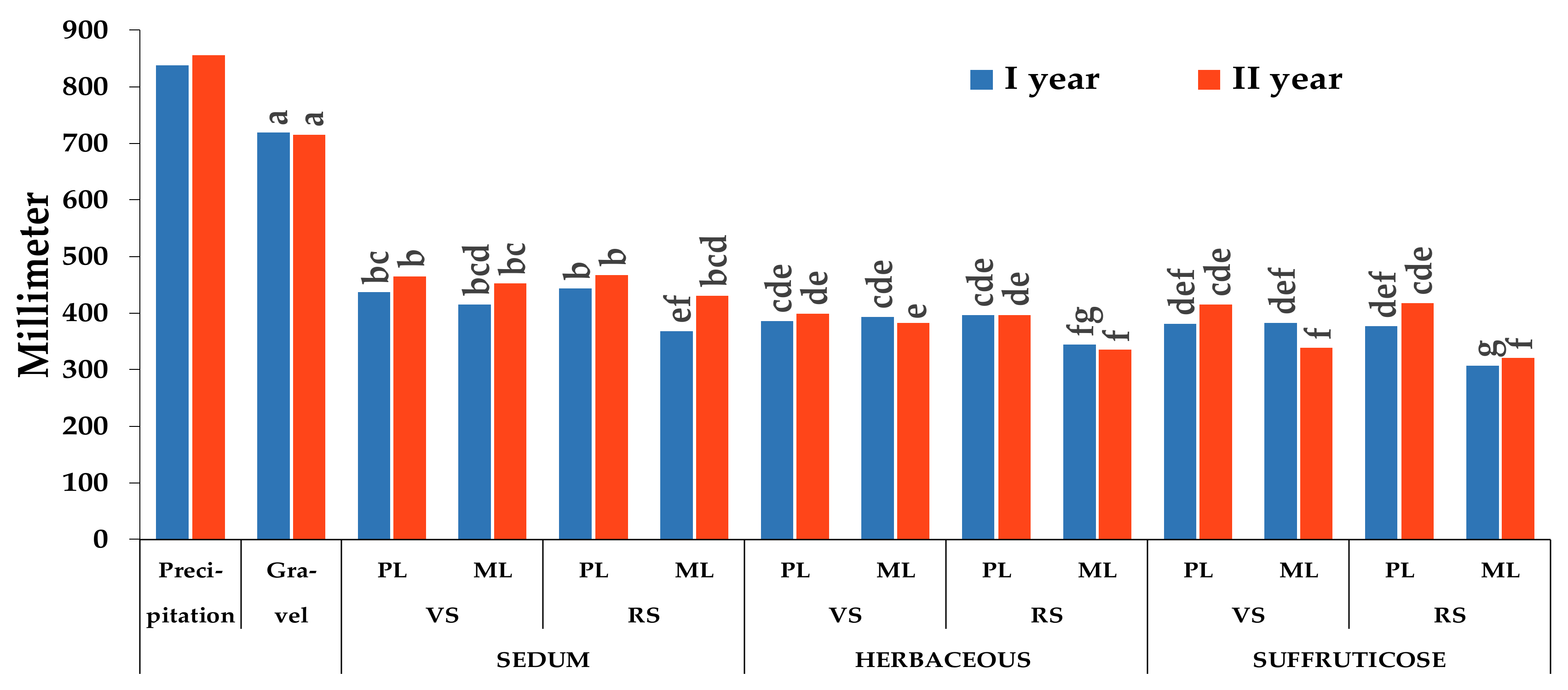
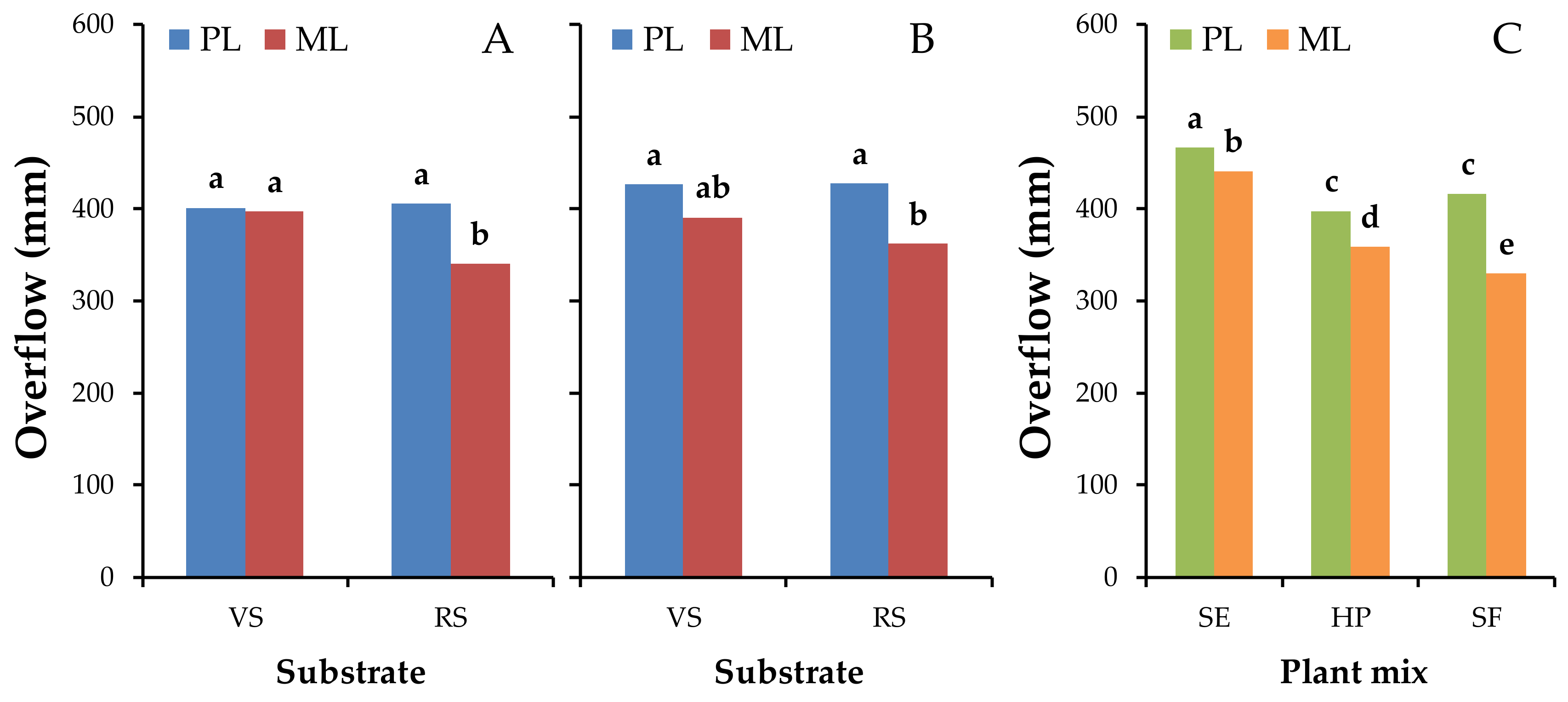
| Green-Roof Layer | Layer Type | Composition | Thickness (cm) | Permeability (mm/min) * | Water Retention Capacity (mm) |
|---|---|---|---|---|---|
| Substrates | Volcanic substrate (VS) | Pumice-stones, volcanic lapillus, and blonde peat | 12.0 | 0.6–6.0 b | 36 a |
| Recycled substrate (RS) | Recycled crushed bricks plus compost and fibrous matter | 12.0 | 0.6–70 b | 48 ± 12 a | |
| Drainage/ storage layers | Preformed HDPE layer (PL) | Recycled high-density polyethylene | 4.4 (4.0 + 0.4) | - | 16.5 (13.5 + 3) |
| Mineral layer (ML) | Expanded perlite bags of calendered geotextile | 5.4 (5.0 + 0.4) | 400 | 18.0 |
| Fall 2014 | Winter 2014–15 | Spring 2015 | Summer 2015 | Fall 2015 | Winter 2015–16 | Spring 2016 | Summer 2016 | Total | |
|---|---|---|---|---|---|---|---|---|---|
| Precipitation | 326.0 | 169.3 | 200.6 | 143.1 | 133.6 | 177.7 | 316.0 | 228.8 | 1695.1 |
| Gravel | 281.5 (86.3%) | 155.0 (91.6%) | 176.7 (88.1%) | 105.4 (73.7%) | 109.2 (81.7%) | 158.0 (88.9%) | 259.0 (82.0%) | 189.8 (83.0%) | 1434.6 (84.6%) |
| SE-RS-PL | 182.4 (56.0%) | 134.1 (79.2%) | 91.4 (45.6%) | 35.9 (25.1%) | 37.0 (27.7%) | 142.2 (80.0%) | 186.8 (59.1%) | 102.1 (44.6%) | 911.9 (53.8%) |
| SE-VS-PL | 197.0 (60.4%) | 137.9 (81.5%) | 91.0 (45.4%) | 11.0 (7.7%) | 33.7 (25.2%) | 146.5 (82.4%) | 183.5 (58.1%) | 101.5 (44.4%) | 902.1 (53.2%) |
| SE-VS-ML | 197.2 (60.5%) | 139.0 (82.1%) | 79.2 (39.5%) | 0.0 (0.0%) | 25.0 (18.7%) | 148.3 (83.5%) | 185.9 (58.8%) | 92.5 (40.4%) | 867.1 (51.2%) |
| SE-RS-ML | 159.6 (49.0%) | 132.9 (78.5%) | 70.7 (35.2%) | 5.2 (3.6%) | 24.4 (18.3%) | 150.0 (84.4%) | 175.6 (55.6%) | 80.9 (35.4%) | 799.2 (47.1%) |
| SF-VS-PL | 167.2 (51.3%) | 135.8 (80.2%) | 74.7 (37.2%) | 4.0 (2.8%) | 28.0 (15.0%) | 140.7 (79.2%) | 183.8 (58.2%) | 62.7 (27.4%) | 796.9 (47.0%) |
| SF-RS-PL | 153.2 (47.0%) | 134.0 (79.1%) | 68.7 (34.2%) | 21.0 (14.7%) | 21.5 (16.1%) | 135.7 (76.4%) | 179.4 (56.6%) | 81.2 (35.5%) | 794.7 (46.9%) |
| HE-RS-PL | 171.7 (52.7%) | 132.2 (78.1%) | 76.4 (38.1%) | 16.5 (11.5%) | 19.1 (14.3%) | 129.0 (72.6%) | 174.5 (55.2%) | 74.5 (32.6%) | 793.9 (46.8%) |
| HE-VS-PL | 172.4 (52.9%) | 133.6 (78.6%) | 78.0 (38.9%) | 2.5 (1.7%) | 19.7 (14.7%) | 134.8 (75.6%) | 175.5 (55.5%) | 68.9 (30.1%) | 785.4 (46.3%) |
| HE-VS-ML | 183.0 (56.1%) | 136.9 (80.9%) | 72.9 (36.3%) | 0.9 (0.6%) | 1.6 (1.1%) | 142.2 (80.0%) | 175.4 (55.5%) | 63.6 (27.8%) | 776.5 (45.8%) |
| SF-VS-ML | 172.2 (52.8%) | 137.9 (81.5%) | 73.0 (36.4%) | 0.0 (0.0%) | 2.0 (1.5%) | 141.1 (79.4%) | 152.5 (48.3%) | 43.2 (18.9%) | 721.8 (42.6%) |
| HE-RS-ML | 150.8 (46.3%) | 129.6 (76.6%) | 62.9 (31.4%) | 1.9 (1.3%) | 2.8 (2.1%) | 124.3 (69.9%) | 156.7 (49.6%) | 51.2 (22.4%) | 680.2 (40.1%) |
| SF-RS-ML | 124.4 (38.2%) | 131.8 (77.8%) | 50.1 (25.0%) | 0.7 (0.5%) | 2.4 (1.8%) | 131.5 (74.0%) | 147.5 (46.7%) | 40.2 (17.6%) | 628.5 (37.1%) |
| Event | 13 October 2014 | 14 June 2015 | 28 July 2016 |
|---|---|---|---|
| Precipitation | 31.2 | 29.2 | 44.0 |
| SE-VS-PL | 52.0 e | 83.0 de | 31.0 de |
| SE-VS-ML | 66.5 cd | 99.8 a | 37.6 d |
| SE-RS-PL | 62.5 de | 55.8 g | 25.7 e |
| SE-RS-ML | 84.7 b | 87.8 cd | 41.3 d |
| HE-VS-PL | 62.9 d | 94.8 bc | 59.8 bc |
| HE-VS-ML | 74.6 c | 100 a | 68.2 b |
| HE-RS-PL | 66.5 cd | 73.6 ef | 35.9 d |
| HE-RS-ML | 87.4 b | 94.2 bc | 59.2 bc |
| SF-VS-PL | 69.1 cd | 97.1 ab | 53.3 c |
| SF-VS-ML | 73.7 c | 100 a | 82.9 a |
| SF-RS-PL | 75.6 c | 65.6 fg | 36.4 d |
| SF-RS-ML | 98.6 a | 99.5 a | 54.7 c |
| Significance | |||
| Plant mix (P) | *** | *** | *** |
| Substrate (S) | *** | *** | *** |
| Drain/storage layer (D) | *** | *** | *** |
| P × S | * | n.s. | *** |
| P × D | n.s. | * | *** |
| S × D | *** | *** | n.s. |
| P × S × D | * | *** | *** |
| First Year | Second Year | |||||||||
|---|---|---|---|---|---|---|---|---|---|---|
| Fall 2014 | Winter 2014–15 | Spring 2015 | Summer 2015 | Year | Fall 2015 | Winter 2015–16 | Spring 2016 | Summer 2016 | Year | |
| Precipitation | 326 | 169.3 | 200.6 | 143.1 | 839 | 133.6 | 177.7 | 316 | 228.8 | 856.1 |
| Gravel | 281.5 | 155 | 176.7 | 105.4 | 718.6 | 109.2 | 158 | 259 | 189.8 | 716 |
| Tr. Average° | 169.3 | 134.6 | 74.1 | 8.3 | 386.3 | 18.1 | 138.8 | 173.1 | 71.9 | 401.9 |
| Plant mix (P) | ||||||||||
| SE | 184.0 a | 136.0 a | 83.1 a | 13.0 a | 416.1a | 30.0 a | 146.7 a | 182.9 a | 94.2 a | 453.9a |
| HP | 169.5 b | 133.1 b | 72.6 b | 5.4 b | 380.6b | 10.8 b | 132.6 c | 170.5 b | 64.6 b | 378.4b |
| SF | 154.3 c | 134.9 a,b | 66.6 c | 6.4 b | 362.2c | 13.4 b | 137.2 b | 165.8 b | 56.8 c | 373.3b |
| Substrate (S) | ||||||||||
| VS | 181.5 a | 136.8 a | 78.1 a | 3.1 b | 399.5a | 18.3 | 142.3 a | 176.1 a | 72.1 | 408.7a |
| RS | 157.0 b | 132.4 b | 70.0 b | 13.5 a | 373.0b | 17.9 | 135.4 b | 170.1 b | 71.7 | 395.0b |
| Drainage/storage layer (D) | ||||||||||
| PL | 174 | 134.6 | 80.1 a | 15.2 a | 403.8a | 26.5 a | 138.1 | 180.6 a | 81.8 a | 427.0a |
| ML | 164.5 | 134.7 | 68.1 b | 1.5 b | 368.8b | 9.7 b | 139.1 | 165.6 b | 61.9 b | 376.8b |
| Significance | ||||||||||
| P | *** | * | *** | *** | *** | *** | *** | *** | *** | *** |
| S | *** | *** | *** | *** | *** | n.s. | *** | * | n.s. | ** |
| D | n.s. | n.s. | *** | *** | *** | *** | n.s. | *** | *** | *** |
| P × S | n.s. | n.s. | ** | ** | n.s. | n.s. | ** | n.s. | n.s. | n.s. |
| P × D | n.s. | n.s. | n.s. | *** | n.s. | ** | * | *** | * | ** |
| S × D | ** | * | *** | *** | *** | n.s. | n.s. | n.s. | ** | * |
| P × S × D | n.s. | n.s. | n.s. | n.s. | n.s. | n.s. | * | n.s. | n.s. | n.s. |
Publisher’s Note: MDPI stays neutral with regard to jurisdictional claims in published maps and institutional affiliations. |
© 2020 by the authors. Licensee MDPI, Basel, Switzerland. This article is an open access article distributed under the terms and conditions of the Creative Commons Attribution (CC BY) license (http://creativecommons.org/licenses/by/4.0/).
Share and Cite
Bortolini, L.; Bettella, F.; Zanin, G. Hydrological Behaviour of Extensive Green Roofs with Native Plants in the Humid Subtropical Climate Context. Water 2021, 13, 44. https://doi.org/10.3390/w13010044
Bortolini L, Bettella F, Zanin G. Hydrological Behaviour of Extensive Green Roofs with Native Plants in the Humid Subtropical Climate Context. Water. 2021; 13(1):44. https://doi.org/10.3390/w13010044
Chicago/Turabian StyleBortolini, Lucia, Francesco Bettella, and Giampaolo Zanin. 2021. "Hydrological Behaviour of Extensive Green Roofs with Native Plants in the Humid Subtropical Climate Context" Water 13, no. 1: 44. https://doi.org/10.3390/w13010044







